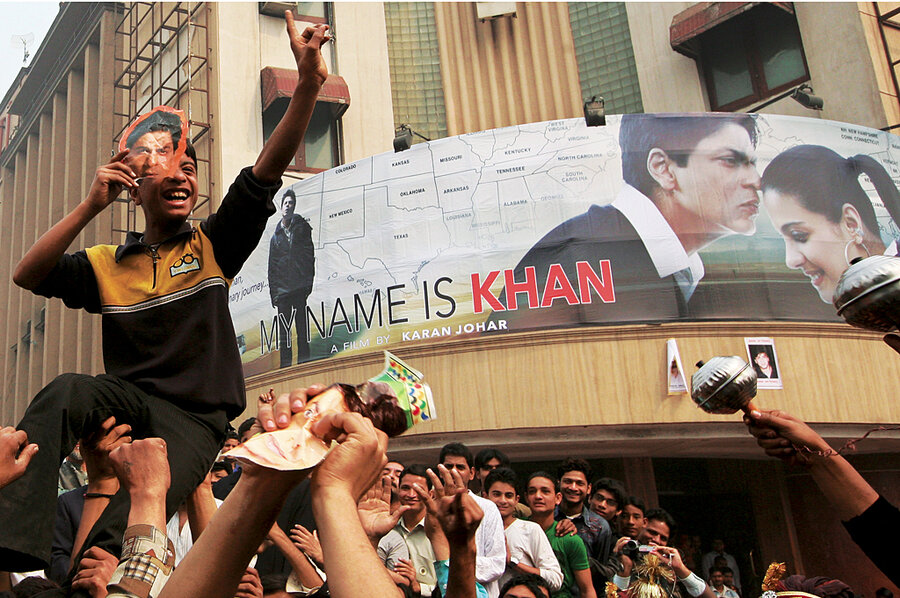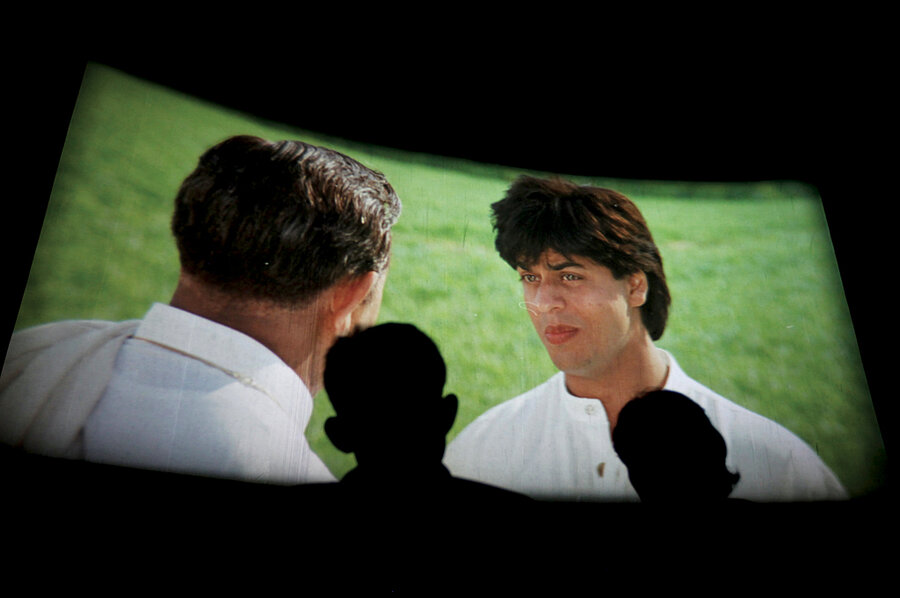Bollywood's global push
Loading...
| Toronto
Nabila Kanji was 7 years old when she fell for Bollywood megastar Shah Rukh Khan. She vividly recalls watching him in "Dilwale Dulhania Le Jayenge" ("The Big Hearted Will Take the Bride"), the epic love story of two first-generation British Indians struggling to persuade their culturally conservative parents that they should be together.
"I remember thinking they were so hip and cool but I could still relate to them because they were like me, like my family," says the second-generation South Asian who grew up in Markham, Ontario.
Ms. Kanji wasn't alone in her love for "DDLJ," as it is referred to by its millions of fans. Released in 1995, it was really the first Hindi film to present a story from the perspective of nonresident Indians. It went on to become the largest-grossing film in Bollywood history and the first to make a significant chunk of its earnings in Western markets.
Kanji has never lost her love of Bollywood or Mr. Khan, who she hopes will make an appearance at the International Indian Film Academy Awards (IIFA) being held in Toronto on June 23-25.
She snagged two $300 tickets for the glamorous awards show and has been offered up to a thousand dollars per ticket. For Bollywood fans, "it's kind of like the royal wedding," she says.
The Hindi-language film industry based in Mumbai has had a global following among the South Asian diaspora and in other Asian, African, and Middle Eastern countries since the 1950s. But over the past decade, the world's most prolific film industry has been making inroads into mainstream North American and European consciousness and in so doing seems to be helping to burnish India's global sheen or its "soft power," to use the term coined by Harvard political scientist Joseph Nye.
Just as the American culture industries, especially Hollywood, were instrumental in constructing and disseminating the narrative about the attraction of the United States that helped make it the most influential player on the world stage in the 20th century, the rise in the popularity of Bollywood films could help to do the same for India in the 21st, Professor Nye says by e-mail from a book tour in Europe.
"Hollywood played a significant role in developing the soft power that helped to end the Cold War. I hope that Bollywood can help India with its image among its neighbors [such as traditional rivals Pakistan and China]," Nye says, who observes that in many countries Bollywood films are more popular than Hollywood films.
Sangita Gopal attributes the enduring popularity of Indian films abroad to the extravagant song-and-dance sequences that don't require viewers to understand the language in order to enjoy them. But the author of "Global Bollywood" says it goes beyond that. "On one level they are utterly commercial, but they also probe themes ... that are incredibly resonant in societies battling between tradition and modernity" – themes such as class, family, and interreligious conflict. "These films often take up the question of how to live with people who are different from you."
This type of social-justice theme wrapped up in "emotion and melodrama is a very powerful narrative form ... in countries like Nigeria, where these films are extremely popular. They are more easy to relate to than Hollywood films," agrees Tejaswini Ganti, an assistant professor of anthropology at New York University and author of the upcoming book "Producing Bollywood: Inside the Contemporary Hindi Film Industry."
Professor Ganti points out that Bollywood has "always been a global cinema.... It is just now that the mainstream American media is catching up."
There are several factors for this increased awareness in the West, she says, including the influx of information-technology workers from India in the 1990s and improved production values. Technology also plays a role: It is much easier to access Bollywood films online, both legally and illegally.
Finally, Ganti says "the Indian government has also finally woken up to this and sees it as something to be promoted now.... [Bollywood] has become part of the Indian package of a contemporary, emerging global power, which is very different from 15 years ago."
Shashi Tharoor, an Indian politician and author at the 2009 TEDIndia (Technology, Entertainment and Design) Conference in Mysore, confirms this. "It is not the side with the bigger army, but the side with the better story, that wins. India is already the 'land of the better story.' As a pluralist society with a free and thriving mass media, creative energies that express themselves in a variety of appealing ways, and a democratic system that promotes and protects diversity, India has an extraordinary ability to tell stories that are more persuasive and attractive than those of its rivals," such as other emerging global powers like China.
Beth Watkins, who blogs about Bollywood from the Chicago area and is coming up for the IIFA awards, says the success of the industry is exemplified by the excitement over the awards show finally coming to North America and "reminds people that India is where big business happens."
Ms. Watkins, who writes the blog "Beth Loves Bollywood," says the appeal of mainstream Indian films is their emotional earnestness. "We would probably find it cheesy in a Western film, but for some reason it just works in these films," she says.
Sabbas Joseph, one of the producers of the 2011 IIFA awards, says in a telephone interview from Mumbai, "Most of our films have the everlasting theme of romance. You find that in any cinema, but presented with different cultural palettes."
The industry has also recognized the business value of capturing global audiences, he says, and to that end is starting to make separate edits for foreign audiences. These versions contain fewer song-and-dance sequences and are shorter than the usual three-plus hours demanded by Indian audiences.
Of the five films nominated for the IIFA awards this year, only one seems to explicitly court a Western audience. "My Name Is Khan," starring Shah Rukh Khan, is about a Muslim immigrant to the US diagnosed with Asperger syndrome who, after Sept. 11, undertakes a journey to tell President Bush that not all Muslims are terrorists. While the film did reasonably well in India, it has become the highest-grossing Bollywood film overseas.
Mr. Joseph insists that fears about Bollywood losing its authenticity as it courts dollars and euros is unfounded. "The Indian film will remain Indian," he says. The reason Bollywood executives chose Toronto as their "North American gateway," he says, was for its large and vibrant South Asian community and because this is a city that loves film. Witness the success of the Toronto International Film Festival (TIFF), which he credits with being among the first to bring critical recognition to his industry.
"Although Hindi films can seem exotic and a bit zany ... this cinema has as storied and complex a tradition of aesthetic construction as Hollywood," says Noah Cowan, an artistic director for TIFF.
"There is a sense of wild abandon in the best Hindi films – a sense of fun and exuberance that might be lost in most Hollywood productions," he says.
In terms of how Bollywood is helping to shape views of India, he says, "I think people take India for granted from a geopolitical perspective. But India has always carved its own path through the world."
Nye confirms the role Bollywood plays in shaping global perspectives on modern India. "When I was in Beijing, I was asked how China could increase its soft power," he says. "I said to learn a lesson from India: Unleash civil society. Do not censor art and film."






